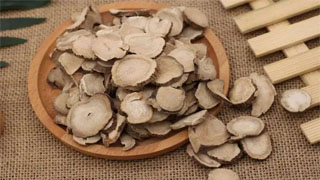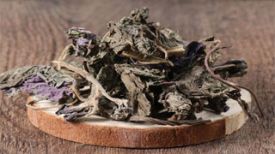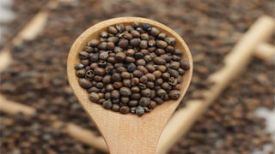
1. Alias
Red peony, wood peony, and red peony.
2. Plant morphology
Perennial herb. Root cylindrical, with single or few branches. The stem is upright, with thick and dull edges, smooth and hairless. Leaves alternate, the lower part of the stem has 2 leaves with 3 leaves, and the leaf outline is oval; Small leaves usually have two deep lobes, with small lobes wide lanceolate to lanceolate, apex acute or sharp, entire margin, sparsely hairy along veins above, hairless or short hairs along veins below. 2-4 flowers grow at the top of the stem and below the leaf axil, with sepals about 4, green in color; Petals 6-9, purple red to pink, broadly ovate; Most stamens, yellow anthers; The floral plate is fleshy and only wraps around the base of the carpel; Heart skin 2-5, separated. The pods are 2-5, densely covered with yellow fine hairs. The flowering period is from June to July, and the fruiting period is from July to September.
3. Origin distribution
Born on the edge of mountain forests and grassy slopes. Distributed in Shaanxi, Gansu, Qinghai, Sichuan and other places.
4. Harvesting and processing
Excavate in spring and autumn, remove roots, fibers, and sediment, and dry in the sun.
5. Characteristics of medicinal herbs
Cylindrical, slightly curved, 5-40 centimeters long, 0.5-3 centimeters in diameter. The surface is brown, rough, with longitudinal grooves and wrinkles, as well as fibrous root marks and horizontally protruding skin holes. Some outer skins are prone to peeling off. Hard and brittle in texture, easy to break, with white or pink flour, narrow skin, obvious radial texture on the wood, and some with cracks. The aroma is slightly fragrant, the taste is slightly bitter, and it is sour and astringent.
6. Sexual Taste Returning to the Classics
Slightly cold in nature and bitter in taste. Return to the liver meridian and spleen meridian.
7. Effect and Function
Clear heat, cool blood, disperse stasis and relieve pain. A heat clearing and blood cooling medicine classified under the category of Qingre medicine.
8. Clinical application
Dosage: 6-12 grams, decoct and take orally. Used to treat warm and toxic spots, vomiting and bleeding, eye nourishing swelling and pain, liver depression and rib pain, menstrual cramps, abdominal pain, falls and injuries, and abscesses and sores.
9. Pharmacological research
Antithrombotic; Antiplatelet aggregation; Reduce blood lipids and resist arteriosclerosis; Low dose mildly inhibits the heart, while high dose significantly inhibits the heart and has a conduction block effect, increasing coronary flow and reducing peripheral resistance; Treatment and prevention of decreased heart function. Anti-tumor; It has the effects of protecting the liver, clearing oxygen free radicals, relieving intestinal spasms, and inhibiting bacteria. Has a sodium excretion effect. The extract has a significant inhibitory effect on platelet aggregation induced by adrenaline, ADP, iron headed snake venom, and arachidonic acid in vitro. The decoction has a strong inhibitory effect on typhoid bacilli, dysentery bacilli, Staphylococcus aureus, hemolytic streptococcus, etc. in vitro. Intraperitoneal injection of n-butanol extract has inhibitory effects on S-180 solid tumors in mice. Due to the presence of benzoic acid and phenols in this product, it can be combined with other Chinese herbs as preservatives in cosmetics.
10. Main components
Containing paeoniflorin, neopaeoniflorin, paeoniflorin A, paeoniflorin B, palmitic acid, dihydroapigenin, paeoniflorin, β - sitosterol, camphor hydrocarbons, vanillic acid, vanillic acid, etc.
11. Usage taboos
Not suitable for use with resveratrol. Caution should be exercised when taking medication for cases of blood deficiency without blood stasis, as well as for those with self ulceration or abscess.
12. Compatibility prescription
① Not only does it treat bleeding: Take 6 grams of red peony powder with water. (From "Shi Lin Guang Ji")
② Treatment of intestinal wind induced blood loss: 30g of red peony root, burned on the tile, as powder, mixed with warm wine to make 6g. (Women's Prescription)
③ To treat all types of carbuncles and boils on the back, as well as toxic and malignant sores: divide red peony, Angelica sinensis, and licorice into small parts, take 6 grams each time, adjust to warm wine, regardless of the time. "(" Hygiene Easy Formula ")
④ Treatment of acute mastitis: 30-60 grams of red peony and 6 grams of raw licorice. Boil it in water. If there is a fever, add Scutellaria baicalensis and apply a small amount of white root and salt to the affected area. (Selected Compilation of Investigation Materials for Unilateral Verification)
⑤ Treatment of blood dysentery and abdominal pain: 30g of red peony, 30g of yellow cypress, and 30g of ground elm each. Add three flavors, roughly mash and sieve, take 15 grams per serving. Boil one cup of rice water until it reaches seven tenths, remove impurities, and warm up at any time. (Sheng Ji Zong Lu "Shao Yao Tang)
⊙ The content of the article is for clinical reference only. Non TCM professionals are not allowed to test drugs.


